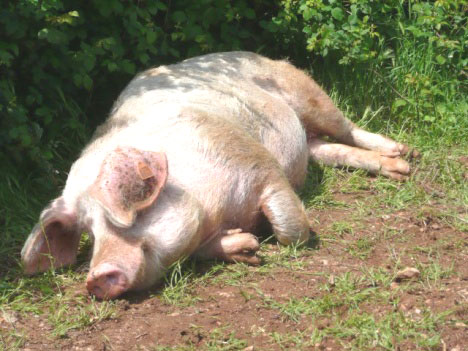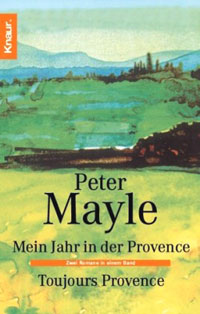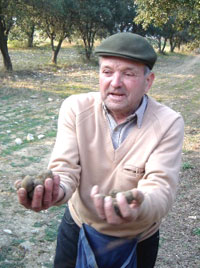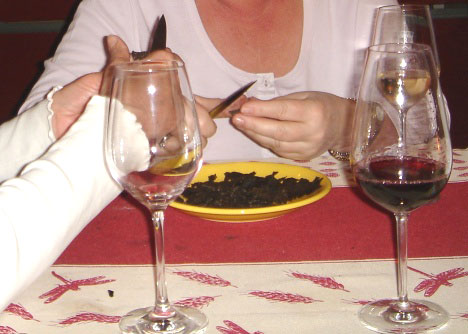Growing up in the farming village, next to the dairy and cheese factory, every squeal and screech of pigs brings back a piece of childhood memory. Oskar, the dairy owner's son, was my best friend. I went in and out of his home, also to see the pigs. In the course of urbanisation, the cheese dairy disappeared from the centre of the village, and with it the stables with the many pigs. I didn't even notice how the pigs disappeared from my consciousness and from then on only existed in the form of bacon, chops and ham.

|
| Happy pig (Photo:pigs.de) |
Later, when I was a young editor at the local newspaper, a woman appeared weekly with a manuscript I had to edit: "My Life with Tin-Tin", or something. The good woman raised a little orphan pig in her living room and bathroom at home and reported on it weekly in the local newspaper. This later became a book for young people (Margrit Helbling: "Romi und Tin-Tin"). But then the pig finally left my life as a bristling animal.
Many years later, when my friends began to rave about living in Provence and we all seriously considered a racking to the south of France, the pig returned to me. This time as a truffle pig. Peter Mayle, the Francophone Englishman, provided the amusing story about this in one of his Provence books: "Trouble with the Truffle Pig".

|
| Peter Mayle: My Year in Provence (Verlag Knaur) |
But truffles became much more important to me than the pig, as a delicacy, as a source of flavour for pasta, omelettes and much, much more refined dishes. In the meantime, having settled half-time in the south of France myself, I unceremoniously declared truffles, black or white, to be my culinary "eye stars". The fact that the truffle sow only finds the rare, hidden mushroom because it is said to smell like boars in heat did not bother me. On the contrary, a piece of piggish familiarity from childhood days returned to me.
All the myths surrounding the truffle, all the mystery surrounding the hidden tuber, all the stories that accompany the precious mushroom made the truffle pig fade away. When I realised that the pigs had long since been replaced by dogs, the common pig finally left me to make room for the mushroom

|
| Fresh truffles from the Province |
However, I quickly landed back on the ground of reality. Truffles - real ones - are now as expensive as the most expensive Bordeaux wines. At the "Halles" in Nîmes this year, a kilo cost 1400 euros, at the market in Villeneuve-Minervois "only" 1200 euros. I was assured that they cost between 850 and 1000 euros at all markets in the region.
Truffles have brought another problem into my life: what to drink with a truffle-flavoured dish? A luxury wine from the Bordelais would be adequate. But I can hardly imagine a Margaux, Haut-Brion or Ausone. Two very different flavours, both of the finest, are fighting each other. So something light, happy, carefree: a top rosé from the south. I have my doubts about that, too. Bruno, my confidant, swears by a Sauvignon Blanc from New Zealand: "a really good combination, creamy as eggs and strong enough to stand up to the truffles."

|
| Truffle growers on the trail of the "black diamond |
Actually, I'm totally confused. And the confusion increases the more I read and think about truffles. First it's the pigs that have been replaced by dogs. Of all things, the cute, curly Lagotto Romagnolo is supposed to be particularly suitable. But then Philippe Barrière, "Monsieur truffe audois", the truffle inspector, destroys my firm conviction that truffles can only be found under acorns and hazelnuts: "That's wrong, only undergrowth doesn't like truffles!" And finally comes the ko blow, truffles from China, only 30 euros a kilo. Monsieur Trüffel rages: "not recognisable to a layman - only after cutting it open, but then it's too late". Truffles from China are supposed to look the same, but taste nothing like them. And now the question of faith about the right wine: a full-bodied wine with pronounced acidity, a Barbera, was recommended to me, or an elegant, very intense, fruity Collio Bianco. Then a Bordeaux, the Durfort-Vivens of all things, which is supposed to contain truffle notes (I have never found this to be the case), even a Riesling Beerenauslese or a Scheurebe appear, a Champagne Rosé or a Pinot Grigio.
Finally, then, in connection with Namibian truffles, I found the ultimate answer: "Drink what you like!"

|
| Truffles and wine |
I can get used to this wine recommendation. Only that there are also truffles in Namibia is new to me. I'm going to Namibia in a month and thought I'd miss the best truffle season in the south of France. It starts now, in mid-January. I don't even need to go to the Périgord, where Buno raves about culinary delights: "Truffles, foie gras, pâté, mushrooms, cheese and good wine".
Yours sincerely